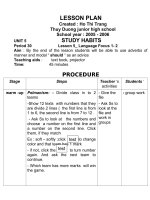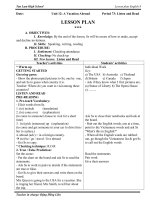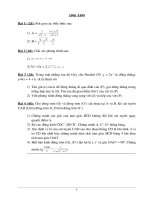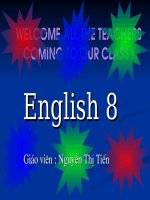ENGLISH 8 PERIOD 97 98 99
Bạn đang xem bản rút gọn của tài liệu. Xem và tải ngay bản đầy đủ của tài liệu tại đây (139.58 KB, 11 trang )
<span class='text_page_counter'>(1)</span><div class='page_container' data-page=1>
Date of lanning:02/05/2021 Period: 97
<b>UNIT 16: INVENTIONS- LISTEN</b>
<b>A. Objectives:</b>
Ss can talk about the inventions using the passive
<b> Language contents:</b>
<i>1. Grammar:</i> Simple present tense, past simple tense (review)
<i>2. Vocabulary:</i>
(n) Facsimile, reinforced concrete, microphone, X-ray, loudspeaker,
helicopter
<i>3. Attitude<b>: be aware of advertisements. </b></i>
<b>B. Preparations</b>
1. Teacher: lesson plan, English 8-book, computer, projectors
2. Students: review the grammar points and vocabulary, English 8-book,
C. Techniques:
Bingo, question and answer
<b>D. Procedures:</b>
<i>1. Greeting and taking attendance(1’)</i>
<i>Class</i> <i>Date of teaching</i> <i>Absentstudents</i>
<i>8B</i> <i>05/05/2021</i>
<i>8C</i> <i>05/05/2021</i>
<i>II. Review of the previous lesson:(5’)</i>
Ss rearrange these sentences as they appear in the dialogue
a. Mr. Roberts advices students not to touch the button.
b. Mr. Roberts shows the children the first step In the manufacturing
process.
c. The children want to test some chocolate.
Key: b-a-c
<i>III. New lesson:</i>
<b>Teacher’s and Students’ activities</b> <b>Content</b>
-Elicit words from Ss
<b>1.. Pre-listening(8’)</b>
ØPre-teach vocabulary
+ procedure (n) (translation)
+ pulp (nu) (question)
(What is used to make paper?)
+ vat (n) (picture/ drawing)
+ drain (v) (explanation)
(to make sth empty or dry by removing all
the liquid from it)
</div>
<span class='text_page_counter'>(2)</span><div class='page_container' data-page=2>
-T elicits words from Ss and writes
them inside circles
-T gets Ss to repeat and rub out the
word, not the circle
-Continue until the circle is empty
-T gets Ss to repeat the rubbed out
words by pointing at the empty
circles
-When Ss seem to remember all the
words, ask Ss (5/6 at a time) to
come to the blackboard to fill in the
circles with the right words
-T informs the topic: paper-making
process
-T has Ss read the sentences
-T plays the tape 2 or 3 times and
ask Ss to fill in the gaps with the
words they catch
-T asks Ss to compare their answer
with their partners
-T calls on Ss to give their answers
-T gives feedback and corrects
-T asks Ss to read the sentences (a
"g) carefully and guess the order
-T writes the Ss’ predictions on the
board
-T plays the tape again and ask Ss to
listen
-T calls on Ss to give their
correction
-T gives feedback and corrects
+ roll (n) (realia)
"Checking technique: What and where
<b>2. While-listening(15’)</b>
ØGap fill
*Answer key:
1. simple 4. left
2. same 5. rollers
3. two hundred
3. Post-listening(8’)
ØOrdering prediction
*Answer key:
c/ Paper pulp was placed in the vat
d/ Paper pulp was mixed with water
a/ The water was drained
e/ The pulp fibers were poured out
g/ The pulp was conveyed under the rollers
Procedure
Vat
Roll
Roller
Pulp
</div>
<span class='text_page_counter'>(3)</span><div class='page_container' data-page=3>
<i>IV. Consolidation:(5’)</i>
* A student acting as “caller” has the pile of separate pictures of
invention, and offer each one in random order, using the questions.
<i>When was the laser invented? And.</i>
<i>Who was the laser invented by?</i>
The group which possesses the item “laser” answer.
<i>The laser was invented by Gordon Gould in 1958</i>
And makes a tick beside the item on the sheet.
The winter is the first group to cover all its sheets
<i>V. Homework:(2’)</i>
-Use the information in the table to write 12 complete sentences in the
…
</div>
<span class='text_page_counter'>(4)</span><div class='page_container' data-page=4>
Date of planning: 02/05/2021 <b>Period: 98</b>
<b>REVISION</b>
<b> </b>
<i><b>A.Objectives:</b></i>
<i><b>1.The aims: By the end of the lesson, Ss will be able to review and remember </b></i>
how to use in order to and so as to to indicate purposes, make and respond to
requests, offers and promises, form the passive and in expressing their feelings
using Adjectives
<i><b>. Language contents:</b></i>
<i>1. Grammar: -</i>Use can, could, will, would to make requests, offers, and
promise.
- Review future simple.
- In order to, so as to.
- Passive in future simple / passive forms
- Adjectives followed by –an infinitive / a noun clause
<i>2. Vocabulary: </i>review
<b>B. Preparations</b>
1. Teacher: lesson plan, English 8-book, computer, projectors
2. Students: review the grammar points and vocabulary, English 8-book
<i><b>C.Techniques:</b></i>
Question and answer, eliciting
<i><b>D.Procedures:</b></i>
<i>1. Organization –</i>
<i>Greeting and taking attendance1. </i>
Class Date of teaching Absent students
8B 06/05/2021
8C 06/05/2021
<i>2. Review of the previous lesson:</i>
No checking
<i>3. New lesson:</i>
<b>Teacher’s and Students’ activities</b> <b>Content</b>
-T asks ss to go to the board and write
the form
- Ss go to the board and write the form
-T corrects and remarks
- T gives examples
- Ss notice and copy.
1. in order to / so as to (5’)
In order to / so as to + V( bare –
inf )
*express a purpose
Ex: He’s going to get to work
earlier in order to impress the boss.
He’s going to work harder <b>in</b>
<b>order to achieve more.</b>
</div>
<span class='text_page_counter'>(5)</span><div class='page_container' data-page=5>
-T asks ss to go to the board and write
the form.
- Ss go to the board and write the form
-T corrects and remarks
- T gives examples
- Ss notice and copy.
-T asks ss to go to the board and write
the form
- Ss go to the board and write the form
-T corrects and remarks
- T gives examples
- Ss notice and copy.
the street in order to reduce traffic
noise.
We crept up the stairs in order
<b>to not to wake Jane.</b>
2. Modal will to make requests,
offers and promises(5’)
Ex: Will/Would you (please) open
the door for me? (promise)
Will you carry that packet for
me? (offer)
He will pass his coming exam.
He promises. (promise)
3. Passive in future simple/present
simple (5’)
Form : S + will / shall + be + past
<b>participle </b>
<b> S + am/is/are + PP</b>
Ex: Coffee is grown in Kenya
The letter will be written (by
me)
The man was eaten by the shark.
<i><b>Requests:</b></i>
<b>Will/Would you + V…?</b>
Answer:
<i>+) Sure/OK/Alright</i>
<i>-) Sorry, I can’t/I’m afraid not</i>
<i><b>Offers:</b></i>
<b>Will/Won’t you have…?</b>
Answer:
<i>+) Yes, please/That would be</i>
<i>nice.</i>
<i>-) No, thank you</i>
<i><b>Promises:</b></i>
<b>I will…… I promise</b>
<b>I promise I’ll.</b>
<b>I promise I won’t</b>
Answer:
</div>
<span class='text_page_counter'>(6)</span><div class='page_container' data-page=6>
-T asks ss to go to the board and write
the form
- Ss go to the board and write the form
-T corrects and remarks
- T gives examples
- Ss notice and copy.
-T asks ss to go to the board and write
the form
- Ss go to the board and write the form
-T corrects and remarks
- T gives examples
- Ss notice and copy.
-T asks ss to go to the board and write
the form
- Ss go to the board and write the form
-T corrects and remarks
- T gives examples
- Ss notice and copy.
4. * Adjective + to infinitive (5’)
Form : It + be + adjective + to
<b>infinitive </b>
* Adjectives + that / noun clause :
Form : S + be + Adj + that / noun
<b>clause </b>
Ex: He was foolish to leave the
company.
You must be stupid to ask for
money.
He’s eager to help us in any way
he can.
I am glad that you want to know
more about 3R.
<b>5.”-ed” and “–ing” participles(5’)</b>
<i>a. “-ed” participle</i>
Form :
Regular verb-ed past
Irregular verb - Column 3
participle
Use: A past participle (phrase) can
be used as an adjective to qualify a
noun with passive meaning.
<i>Ex:</i> The decisions <i>made at today’s</i>
<i>meeting</i> will affect all of us.
<i>b. “-ing” participle</i>
<b>Form : V-ing </b> present participle
<b>Use: A present participle (phrase)</b>
<i><b>can be used as an adjective to</b></i>
<i><b>qualify a noun with active</b></i>
<i><b>meaning.</b></i>
<i>Ex:</i> The man sitting next to Ba is
my father.
*Note: some adjectives also end in
–ing or –ed. These can be explain as
follow:
</div>
<span class='text_page_counter'>(7)</span><div class='page_container' data-page=7>
-T asks ss to go to the board and write
the form
- Ss go to the board and write the form
-T corrects and remarks
- T gives examples
- Ss notice and copy.
-T asks ss to go to the board and write
the form
- Ss go to the board and write the form
-T corrects and remarks
- T gives examples
- Ss notice and copy.
-T asks ss to go to the board and write
the form
- Ss go to the board and write the form
-T corrects and remarks
- T gives examples
- Ss notice and copy.
state that continues over a period of
time
-adjectives ending in –ed describe
people’s feeling
<b>6. “mind” in making requests(5’)</b>
Form:
Would you mind if + S +V(2/ed)..?
Would you mind + V-ing…?
Do you mind if+S+V(bare
infi./-es/-s).?
Do you mind + V-ing…?
<i>Ex:</i> Would you mind if I opened the
door?
Would you mind opening the
door?
Do you mind if I borrow your
book?
<b>7. Past progressive(5’)</b>
Form:
+) S + was/were + V-ing…?
-) S + wasn’t/weren’t + V-ing…?
?) Was/ Were + S + V-ing…?
Yes, S +was/were
No, S + wasn’t/weren’t
*Yesterday, ago, last (week, month,
…) are usually used.
*Past progressive + when + past
simple
*Past simple + while + past
progressive
Ex: I was practicing the guitar at 7
last night.
<i>Ex: </i>I was practicing English at 7
last night.
The door bell rang while I was
having a bath
<b>8. Progressive with “always”(5’)</b>
<i><b>Form:</b></i>
S + be(present form) + always +
V-ing
</div>
<span class='text_page_counter'>(8)</span><div class='page_container' data-page=8>
Ex: You are always talking in
class.
<i>4. Consolidation(2’)</i>
T reminds ss of the structures above
<i>5. Homework:(2’)</i>
- See: Grammar notes from Unit 11 to unit 14
</div>
<span class='text_page_counter'>(9)</span><div class='page_container' data-page=9>
Date of planning: 02/05/2021 <b>Period: 99</b>
<b>REVISION</b>
<i><b>A. Objectives:</b></i>
1.The aims: By the end of the lesson, ss will be able to review and remember:
- passive form;
- compound words;
-Reported speech
<i><b>. Language contents:</b></i>
<i>1. Grammar:</i> review: passive form, compound words, reported speech
<i>2. Vocabulary:</i> review (unit 13-14)
<b>B. Preparations</b>
1. Teacher: lesson plan, English 8-book, computer, projectors
2. Students: review the grammar points and vocabulary, English 8-book,
<i><b>C. Techniques:</b></i>
Question and answer
<i><b>D. Procedures:</b></i>
<i><b>1. Organization </b></i>
<i>. Greeting and checking the attendance</i>
Class Date of teaching Absent students
8B 08/05/2021
8C 08/05/2021
<i>2. Review of the previous lesson</i>
No checking
<i>3. New lesson:</i>
<b>Teacher’s and students’ activities</b> <b>Content</b>
1. Activity (8’)
1. Passive form
-T asks ss to go to the board and write
the form
- Ss go to the board and write the form
-T corrects and remarks
- T gives examples
- Ss notice and copy.
2. Activity 2.( 10’)
-T asks ss to go to the board and write
the form
- Ss go to the board and write the form
-T corrects and remarks
1. Passive form
Form: S + be + PP
*How to change from active to
passive
Active: S + V + O
Passive: S + be + pp + (by O)
Note: The verb in the active form
and be in the passive form must be
put in the same tense
<i>Ex:</i> My car was repaired yesterday.
2. Compound words
</div>
<span class='text_page_counter'>(10)</span><div class='page_container' data-page=10>
- T gives examples
- Ss notice and copy.
3. Activity 3: (15’)
- Reported speech
-T asks ss to go to the board and write
the form
- Ss go to the board and write the form
-T corrects and remarks
- T gives examples
- Ss notice and copy.
-T asks ss to go to the board and write
the form
- Ss go to the board and write the form
-T corrects and remarks
- T gives examples
- Ss notice and copy.
-T asks ss to go to the board and write
the form
- Ss go to the board and write the form
-T corrects and remarks
- T gives examples
- Ss notice and copy.
3. Reported speech
Form: reported speech with
questions:
S + asked/wondered + O +if/whether
+ S + V + …
Ex: “Does your father work here?”
she asked
<i>-She asked if my father work there</i>
“Are you in a busy?” He asked
<i>-He asked if I was in a busy.</i>
Report direct speech
S + said + S + V (past form vs. the
verb tense)
Ex: Sailly said: “I’m going to the
bookshop.”
<i>-Sailly said she was going to the</i>
<i>bookshop.</i>
Mai told us: “It’s going to rain.”
<i>-Mai told us it was going to rain.</i>
Report an advice
S + said + S + should + V…
Ex: My mother said: “ You shouldn’t
stay up late because it is harmful to
your health.
<i>-My mother said I shouldn’t stay up</i>
<i>late because it is harmful to my</i>
<i>health.</i>
<i><b>*tense</b></i>
Present simple >past simple
Will > would
Must > had to
Can > could
</div>
<span class='text_page_counter'>(11)</span><div class='page_container' data-page=11>
Now > then
Here > there
Today > that day
Tomorrow > the next day
yesterday > the day before
ago > before
<b>4. Consolidation(2’)</b>
T reminds ss of the structures above.
<b>5. Homework:(2’)</b>
</div>
<!--links-->









